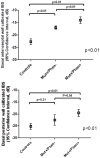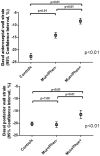Myocardial structural alteration and systolic dysfunction in preclinical hypertrophic cardiomyopathy mutation carriers
- PMID: 22574137
- PMCID: PMC3344846
- DOI: 10.1371/journal.pone.0036115
Myocardial structural alteration and systolic dysfunction in preclinical hypertrophic cardiomyopathy mutation carriers
Abstract
Background: To evaluate the presence of myocardial structural alterations and subtle myocardial dysfunction during familial screening in asymptomatic mutation carriers without hypertrophic cardiomyopathy (HCM) phenotype.
Methods and findings: Sixteen HCM families with pathogenic mutation were studied and 46 patients with phenotype expression (Mut+/Phen+) and 47 patients without phenotype expression (Mut+/Phen-) were observed. Twenty-five control subjects, matched with the Mut+/Phen- group, were recruited for comparison. Echocardiography was performed to evaluate conventional parameters, myocardial structural alteration by calibrated integrated backscatter (cIBS) and global and segmental longitudinal strain by speckle tracking analysis. All 3 groups had similar left ventricular dimensions and ejection fraction. Basal anteroseptal cIBS was the highest in Mut+/Phen+ patients (-14.0±4.6 dB, p<0.01) and was higher in Mut+/Phen- patients as compared to controls (-17.0±2.3 vs. -22.6±2.9 dB, p<0.01) suggesting significant myocardial structural alterations. Global and basal anteroseptal longitudinal strains (-8.4±4.0%, p<0.01) were the most impaired in Mut+/Phen+ patients as compared to the other 2 groups. Although global longitudinal strain was similar between Mut+/Phen- group and controls, basal anteroseptal strain was lower in Mut+/Phen- patients (-14.1±3.8%, p<0.01) as compared to controls (-19.9±2.9%, p<0.01), suggesting a subclinical segmental systolic dysfunction. A combination of >-19.0 dB basal anteroseptal cIBS or >-18.0% basal anteroseptal longitudinal strain had a sensitivity of 98% and a specificity of 72% in differentiating Mut+/Phen- group from controls.
Conclusion: The use of cIBS and segmental longitudinal strain can differentiate HCM Mut+/Phen- patients from controls with important clinical implications for the family screening and follow-up of these patients.
Conflict of interest statement
Figures






References
-
- Maron BJ, Gardin JM, Flack JM, Gidding SS, Kurosaki TT, et al. Prevalence of hypertrophic cardiomyopathy in a general population of young adults : Echocardiographic analysis of 4111 subjects in the CARDIA study. Circulation. 1995;92:785–789. - PubMed
-
- Gersh BJ, Maron BJ, Bonow RO, Dearani JA, Fifer MA, et al. 2011 ACCF/AHA Guideline for the Diagnosis and Treatment of Hypertrophic Cardiomyopathy: A Report of the American College of Cardiology Foundation/American Heart Association Task Force on Practice Guidelines. Circulation. 2011;124:e783–831. - PubMed
-
- Maron BJ, Seidman JG, Seidman CE. Proposal for contemporary screening strategies in families with hypertrophic cardiomyopathy. J Am Coll Cardiol. 2004;44:2125–2132. - PubMed
-
- Nagueh SF, Bachinski LL, Meyer D, Hill R, Zoghbi WA, et al. Tissue doppler imaging consistently detects myocardial abnormalities in patients with hypertrophic cardiomyopathy and provides a novel means for an early diagnosis before and independently of hypertrophy. Circulation. 2001;104:128–130. - PMC - PubMed
-
- Ho CY, Sweitzer NK, McDonough B, Maron BJ, Casey SA, et al. Assessment of diastolic function with Doppler tissue imaging to predict genotype in preclinical hypertrophic cardiomyopathy. Circulation. 2002;105:2992–2997. - PubMed
Publication types
MeSH terms
LinkOut - more resources
Full Text Sources
Miscellaneous

